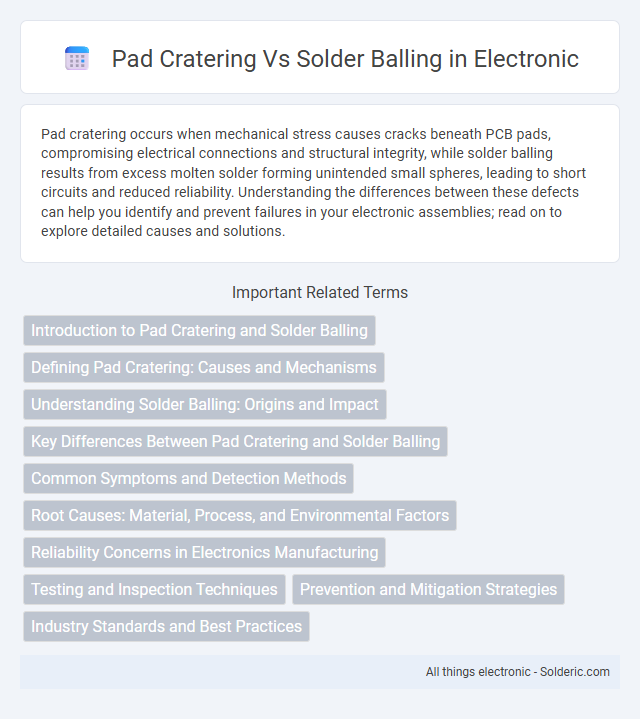Pad cratering occurs when mechanical stress causes cracks beneath PCB pads, compromising electrical connections and structural integrity, while solder balling results from excess molten solder forming unintended small spheres, leading to short circuits and reduced reliability. Understanding the differences between these defects can help you identify and prevent failures in your electronic assemblies; read on to explore detailed causes and solutions.
Comparison Table
| Aspect | Pad Cratering | Solder Balling |
|---|---|---|
| Definition | Mechanical fracturing of the PCB pad substrate | Formation of unintended solder balls on the PCB surface |
| Cause | Excessive mechanical stress or bending | Improper solder paste application or flux residue |
| Location | Underneath component pads | On or around solder joints |
| Impact | Electrical opens or intermittent connections | Short circuits or PCB contamination |
| Detection Method | Cross-section microscopy or X-ray inspection | Visual inspection or automated optical inspection (AOI) |
| Prevention | Control mechanical stress; proper PCB design | Optimize solder paste printing; clean PCB surfaces |
Introduction to Pad Cratering and Solder Balling
Pad cratering is a mechanical failure mode in printed circuit boards (PCBs) where internal delamination occurs beneath the copper pad, often caused by excessive flexural stress. Solder balling refers to the formation of small, unwanted solder spheres on PCB pads during the soldering process, often resulting from improper thermal profiles or flux application. Both defects critically affect electronic assembly reliability, with pad cratering compromising mechanical integrity and solder balling leading to short circuits or poor electrical connections.
Defining Pad Cratering: Causes and Mechanisms
Pad cratering occurs when mechanical stress fractures the substrate beneath the PCB pad, causing a crack between the laminate and copper layer. This failure mechanism is often triggered by board flexing during assembly or thermal cycling, leading to a weakened solder joint and potential device failure. Understanding the causes of pad cratering helps you implement design changes and material selections to enhance PCB reliability and minimize costly defects.
Understanding Solder Balling: Origins and Impact
Solder balling originates from excessive flux residue, improper solder paste printing, or rapid cooling during reflow, causing tiny solder spheres to form on the PCB surface. This phenomenon can lead to short circuits, signal integrity issues, and reduced joint reliability, significantly impacting your electronic device's performance. Understanding these causes helps in optimizing reflow profiles and cleaning processes to mitigate solder ball formation effectively.
Key Differences Between Pad Cratering and Solder Balling
Pad cratering is a mechanical failure characterized by cracks in the printed circuit board (PCB) substrate beneath the pad, often caused by flexural stress during assembly or service. Solder balling refers to the formation of unintended solder spheres on the PCB surface, typically due to flux residues, inadequate soldering profiles, or excessive solder paste. Unlike solder balling, which affects solder joint integrity and electrical connectivity, pad cratering compromises the PCB's structural reliability and can lead to catastrophic failures under mechanical stress.
Common Symptoms and Detection Methods
Pad cratering presents common symptoms like lifted or cracked pads and intermittent circuit failures, often detected through visual inspection and cross-section analysis. Solder balling appears as small, metallic spheres on the PCB surface, which can be identified using X-ray imaging and surface microscopy. Your ability to differentiate these defects relies on spotting physical signs and employing precise diagnostic tools.
Root Causes: Material, Process, and Environmental Factors
Pad cratering primarily results from mechanical stress on the PCB laminate beneath pads, often caused by excessive flexing, improper solder mask application, or thermal cycling. Solder balling is commonly attributed to contaminated surfaces, high flux residue, or incorrect reflow profiles leading to insufficient wetting or solder paste instability. Environmental factors such as humidity and temperature fluctuations exacerbate both defects by affecting material integrity and solder joint reliability.
Reliability Concerns in Electronics Manufacturing
Reliability concerns in electronics manufacturing arise from pad cratering and solder balling, both of which compromise joint integrity and long-term device performance. Pad cratering results from mechanical stress causing fractures in the PCB laminate beneath solder pads, leading to intermittent connections and potential device failure under thermal cycling. Solder balling originates from improper solder paste application or reflow profiles, creating unwanted solder spheres that can cause short circuits and reduced electrical reliability.
Testing and Inspection Techniques
Testing and inspection techniques for pad cratering primarily involve cross-section analysis and scanning acoustic microscopy (SAM) to detect micro-cracks and delamination beneath component pads. In contrast, solder balling is commonly identified through X-ray inspection and automated optical inspection (AOI), which reveal irregular solder ball formation and voids on the PCB surface. You can enhance defect detection accuracy by combining these nondestructive methods with functional electrical testing to ensure circuit reliability.
Prevention and Mitigation Strategies
Effective prevention of pad cratering involves optimizing PCB material selection, controlling drill parameters, and implementing proper board handling techniques to reduce mechanical stress. To mitigate solder balling, ensure precise solder paste application, maintain consistent reflow profile temperatures, and use high-quality fluxes to promote proper solder wetting and minimize splatter. Your manufacturing process benefits from regular inspection and process adjustments targeting these specific defects to enhance overall solder joint reliability.
Industry Standards and Best Practices
Industry standards such as IPC-A-610 and IPC-J-STD-001 provide clear guidelines for identifying and mitigating pad cratering and solder balling in PCB assembly. Best practices emphasize proper material selection, controlled soldering profiles, and rigorous cleanliness to prevent pad cratering caused by mechanical stress and solder balling from flux residues or surface contamination. Consistent inspection using Automated Optical Inspection (AOI) and X-ray techniques aligns with these standards to ensure solder joint reliability and reduce defects in high-volume manufacturing.
pad cratering vs solder balling Infographic

 solderic.com
solderic.com